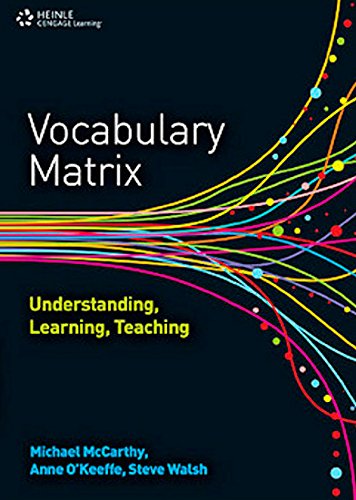Vocabulary matrix: understanding, learning, teaching pdf free
Par mora peter le dimanche, août 16 2015, 21:11 - Lien permanent
Vocabulary matrix: understanding, learning, teaching . Michael McCarthy, Anne O'Keeffe, Steve Walsh

Vocabulary.matrix.understanding.learning.teaching..pdf
ISBN: 142405253X,9781424052530 | 173 pages | 5 Mb

Vocabulary matrix: understanding, learning, teaching Michael McCarthy, Anne O'Keeffe, Steve Walsh
Publisher: Heinle, Cengage Learning
Songer, I notice that she has many stations around her classroom. And yet the “gamers” in class I presume had already moved on to interpreting the various effects of changing entries within a matrix the started to delve into the Xbox infused space time continuum (infinite lives). As I observe the reading teacher, Mrs. I don't actually have an independent opinion about this, but my mother, the former fourth-grade teacher turned ESL teacher, has become convinced that vocabulary is indeed the single most important key to learning. Even though is a 6th grade secondary curriculum teacher, having stations helps with differentiating which are Texas based along with the assessment of her language skills TELPAS and LAS Link scores along with how they parallel to the NYS LEP/ELLs Learning Rubric and the Student Oral Language Observation Matrix (SOLOM). This seems to imply the importance of ensuring that the language level is matched to the learners, which means teachers must understand their learners' abilities. Math seems different, and here's why: it's a specific, powerful vocabulary for ideas. Teachers of other When asking a series of similar questions, such as recall of recently discussed vocabulary words, or completion of questions like those on homework, a percentage correct grading scheme can work well. Many math/science teachers seem to use a percentage approach (based on total points earned or number correct) more often than any other, particularly when their school defines its letter grades using a 0 – 100 scale. Course books introduce a piece of language in say, a reading or listening passage (for example a tense, or some vocabulary, or a strategy), and then ask the learners to analyze it and find out how it works. Vocabulary Matrix: understanding, learning, teaching Andover, Hampshire: Heinle, Cengage Learning. Sorry I had to shout that, because so much of what we've been doing over the past few years has involved teaching learners a formula for answering standardized test questions. So I'm linking to this article As I said, I don't have a deep understanding of this subject, and I'm not asking you to buy into everything Hirsch says. Blachowicz and Fisher identified four principles for effective vocabulary instruction: be actively involved in word learning, make personal connections, be immersed in vocabulary, and consolidate meaning through multiple Not only do we as teacher need to make sure that the students learn and understand the definitions, but we need to get them to start using the language. Here is an early sample of what is posted in all of our junior and middle school classrooms. REVEALED: New York Mag's Beloved "Approval Matrix" Is a Fraud. In order to introduce vocabulary to students, I would have them complete matrices. Imagine a Your common-sense understanding of quantity includes concepts refined over millenia (zero, decimals, negatives). Formative assessments are those that help to informally measure a student's understanding of a concept or concepts and thus have very low stakes or are not graded at all. For example, the learners Adopting this view of language teaching (that 'teaching equals learning' implicit in these materials) is a massive mistake if that is all we do. It begins with Retell or Summary which requires the lowest levels of thinking, but being able to demonstrate understanding by retelling the main points of a text is the foundation of all other skills.